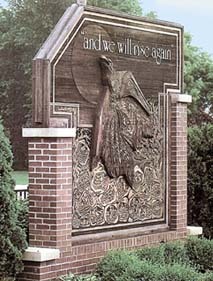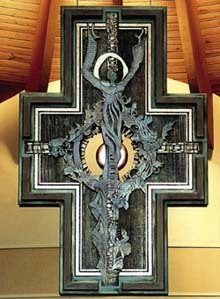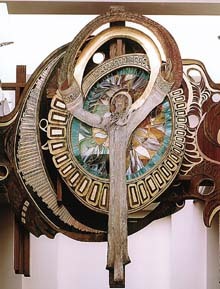With December’s arrival, Christians around the world will once again observe long-standing Yuletide traditions. Whether it be the practice of Las Posadas in Mexico (where believers recreate Mary and Joseph’s search for shelter for nine nights, and are ritually denied entry until Christmas Eve), the consumption of brandy-doused plum pudding in Great Britain or the American standards of bedecked Christmas trees, eggnog and It’s a Wonderful Life, every country has its rituals.
In the midst of the season’s frenetic pace (not to mention the often mercenary behavior of parents searching for the last inventory of the season’s hottest toy), it’s sometimes easy to forget the true "reason for the season": the birth of Jesus Christ. However, surveying the work of Anthony Bellomo and his employees at A.J. Bellomo Studios and Black Forest Building Co. (Mt. Clemens, MI) is ample affirmation that, to quote the Ghost of Christmas Present, "The spirit of Christmas lives not in the hearts of men one day a year; he lives the whole 365."
Finding a calling
Anthony Bellomo grew up in a devoutly Catholic home in suburban Detroit and had a mechanically inclined father — he worked as a rigger at Ford’s Rouge plant and supervised the family’s construction of its own swimming pool. These factors helped Bellomo chart his current career, which he considers "a form of ministry."
He served as an art educator in Chicago and Detroit prep schools, and also taught part-time at the Center for Creative Studies in Detroit. In 1984, he left the education profession and devoted his fulltime career to the Black Forest Building Co., a construction company he founded five years before. The company’s largest creation involved partnering with two other firms to build a 76,000-sq.-ft. shopping center.
His knowledge of construction and his religious convictions led him to also found A.J. Bellomo Studios, which he officially incorporated approximately three years ago. Both companies create religious signage and graphics: Black Forest typically fabricates entry and monument signs, while A.J. Bellomo Studios creates cruciforms and other religious elements. To capture the personality of a church or religiously oriented institution, he meets with parish priests or other representatives.
"As a fine or commercial artist, I feel that the pieces I’m creating emulate the spirit of those I’m working for," Bellomo explains. "Sacred places are where people think, pray and express their beliefs. When meeting with clients for religious artwork, I feel that it’s important to understand what they believe, how they express their faith and what makes them unique. Further, I’ve found that getting to know your client on a more personal level helps when designing any type of commercial work, whether it be a sign or remodeling a home."
Divine technique
Black Forest Building and A.J. Bellomo Studios employ seven people, including a painter, a computer-graphics expert and an embroidery specialist. His two businesses encompass 11,000- and 3,000-sq.-ft. studios. He subcontracts some of his more intricate pieces, such as those that require detailed metal work, to specialists in the Great Lakes Area.
A.J. Bellomo Studios designed a two-sided sign for Sacred Heart Catholic Cemetery in Roseville, MI. Bellomo and his staff carved and sandblasted the 10 x 8-ft. sign face entirely from laminated slabs of redwood that were formed into a contiguous piece. Then, they fastened the piece to integral steel supports by bolting and plugging the substrate to the surface, which was set into a bordering brick structure and accented by surrounding hedges.
The sign’s lettering is carved to be slightly dimensional and handpainted with oil-based paint. The copy at the foot of its front states, "In committing the body to its resting place, the community expresses the hope that, with all of those who have come before, marked with the sign of faith, the deceased awaits the glory of the resurrection."
The back of the sign features intricate carving, including a dimensional eagle — inspired by the Christian song "On Eagles’ Wings," a standard at many funerals — that represents the departed souls’ elevation to the afterlife. Beneath the eagle, Black Forest crafted root-like shapes — symbolizing the foundation of "The Tree of Life" — that contain the Beatitudes, Christ’s eight principles of living virtuously. The base of the sign face features the Stations of the Cross, the succession of events during the Crucifixion. To create the piece’s details, they started with large implements and gradually shifted to smaller tools, beginning with chain saws and concluding with Dremel tools, rotary files, chisels and "whatever would do the job," Bellomo said.


 Tip Sheet3 days ago
Tip Sheet3 days ago
 Business Management1 week ago
Business Management1 week ago
 Women in Signs2 weeks ago
Women in Signs2 weeks ago
 Real Deal4 days ago
Real Deal4 days ago
 Editor's Note1 week ago
Editor's Note1 week ago
 Line Time2 weeks ago
Line Time2 weeks ago
 Product Buying + Technology1 week ago
Product Buying + Technology1 week ago
 Women in Signs4 days ago
Women in Signs4 days ago




















